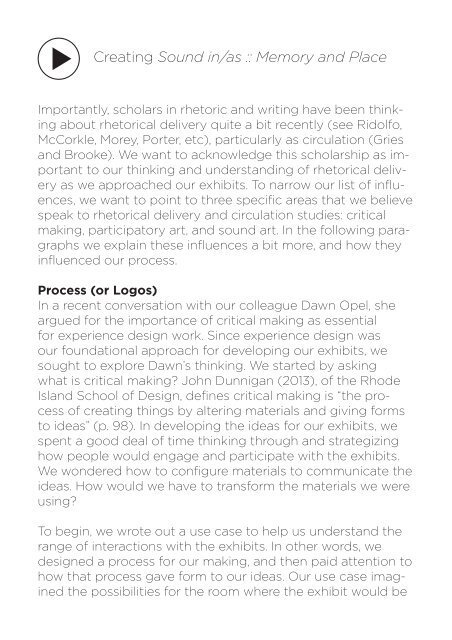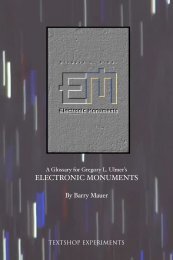Sound in/as :: Memory and Place
Sound in/as :: Memory and Place Symposium on Sound, Rhetoric, and Writing Larissa Babak & Benjamin Lauren Textshop Experiments 6 (2019) TextshopExperiments.org
Sound in/as :: Memory and Place
Symposium on Sound, Rhetoric, and Writing
Larissa Babak & Benjamin Lauren
Textshop Experiments 6 (2019)
TextshopExperiments.org
You also want an ePaper? Increase the reach of your titles
YUMPU automatically turns print PDFs into web optimized ePapers that Google loves.
Creat<strong>in</strong>g <strong>Sound</strong> <strong>in</strong>/<strong>as</strong> :: <strong>Memory</strong> <strong>and</strong> <strong>Place</strong><br />
Importantly, scholars <strong>in</strong> rhetoric <strong>and</strong> writ<strong>in</strong>g have been th<strong>in</strong>k<strong>in</strong>g<br />
about rhetorical delivery quite a bit recently (see Ridolfo,<br />
McCorkle, Morey, Porter, etc), particularly <strong>as</strong> circulation (Gries<br />
<strong>and</strong> Brooke). We want to acknowledge this scholarship <strong>as</strong> important<br />
to our th<strong>in</strong>k<strong>in</strong>g <strong>and</strong> underst<strong>and</strong><strong>in</strong>g of rhetorical delivery<br />
<strong>as</strong> we approached our exhibits. To narrow our list of <strong>in</strong>fluences,<br />
we want to po<strong>in</strong>t to three specific are<strong>as</strong> that we believe<br />
speak to rhetorical delivery <strong>and</strong> circulation studies: critical<br />
mak<strong>in</strong>g, participatory art, <strong>and</strong> sound art. In the follow<strong>in</strong>g paragraphs<br />
we expla<strong>in</strong> these <strong>in</strong>fluences a bit more, <strong>and</strong> how they<br />
<strong>in</strong>fluenced our process.<br />
Process (or Logos)<br />
In a recent conversation with our colleague Dawn Opel, she<br />
argued for the importance of critical mak<strong>in</strong>g <strong>as</strong> essential<br />
for experience design work. S<strong>in</strong>ce experience design w<strong>as</strong><br />
our foundational approach for develop<strong>in</strong>g our exhibits, we<br />
sought to explore Dawn’s th<strong>in</strong>k<strong>in</strong>g. We started by <strong>as</strong>k<strong>in</strong>g<br />
what is critical mak<strong>in</strong>g? John Dunnigan (2013), of the Rhode<br />
Isl<strong>and</strong> School of Design, def<strong>in</strong>es critical mak<strong>in</strong>g is “the process<br />
of creat<strong>in</strong>g th<strong>in</strong>gs by alter<strong>in</strong>g materials <strong>and</strong> giv<strong>in</strong>g forms<br />
to ide<strong>as</strong>” (p. 98). In develop<strong>in</strong>g the ide<strong>as</strong> for our exhibits, we<br />
spent a good deal of time th<strong>in</strong>k<strong>in</strong>g through <strong>and</strong> strategiz<strong>in</strong>g<br />
how people would engage <strong>and</strong> participate with the exhibits.<br />
We wondered how to configure materials to communicate the<br />
ide<strong>as</strong>. How would we have to transform the materials we were<br />
us<strong>in</strong>g?<br />
To beg<strong>in</strong>, we wrote out a use c<strong>as</strong>e to help us underst<strong>and</strong> the<br />
range of <strong>in</strong>teractions with the exhibits. In other words, we<br />
designed a process for our mak<strong>in</strong>g, <strong>and</strong> then paid attention to<br />
how that process gave form to our ide<strong>as</strong>. Our use c<strong>as</strong>e imag<strong>in</strong>ed<br />
the possibilities for the room where the exhibit would be














